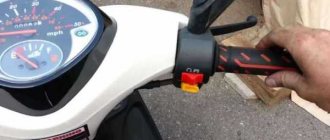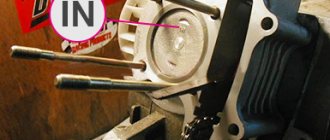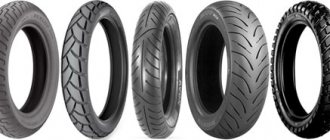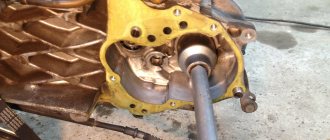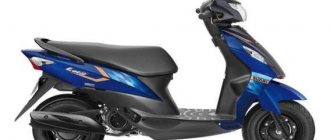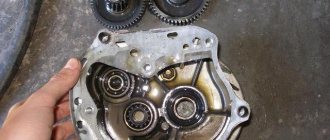To give recommendations for running-in after repair, you should first consider the reasons leading to the repair and methods of restoration. After a comprehensive piston replacement, mandatory running-in of the power unit is required. It should be noted that it is not necessary to resort to replacement if any problems arise with the vehicle, be it poor acceleration, lack of normal starting, and so on. Practice shows that there are only two reasons for a comprehensive piston replacement:
- gradual wear of the piston and cylinder, which leads to poor compression inside the combustion chamber;
- the appearance of scuffing inside due to foreign objects getting into the structure, failure of rings, and so on.
To determine the presence of poor compression, it is enough to use a special device - a compression meter. Having discovered that the compression ratio is less than 7.0 atm, you should think about completely replacing the piston group.
What to do if you don’t have a compression gauge on hand? In this case, the check is carried out in the following way. If you think that the moped is difficult to start due to low compression, just pour a little engine oil into the spark plug hole. Having discovered that the engine starts to start better, the absolute cause of the problem is the presence of poor compression in the engine.
What to do if wear occurs?
Having discovered that the problem lies in the failure of the cylinder-piston group (CPG), you can use two methods. The first is to purchase the entire CPG, but this option requires large financial investments. However, the owner will not have to waste time searching for a turner on his own and will be able to complete the replacement procedure without outside help.
On the other hand, if you have an original cylinder, it becomes possible to bore the worn-out one using turning equipment. The procedure is as follows: the owner takes the old cylinder with him to the turner. The specialist visually assesses the condition, after which he indicates the repair size. There are four in total:
- 0.25
- 0.5
- 0.75
- 1.0
These numbers indicate an increase in millimeters to the existing diameter. This amount of metal is ground down during the processing of the inner walls of the cylinder. When boring, the coefficient of thermal expansion of the metal that occurs during engine operation must be taken into account. Therefore, another fifth hundredth of a millimeter (0.05) is added to the indicated number. This will not affect the compression level in any way, and the power unit will not receive a temperature wedge. After assessing the bore diameter, you will have to buy a repair piston. Having purchased it, they pass it along with the cylinder to the master for boring.
How to properly break in a scooter
After purchasing a new scooter, you have in any case heard from the seller that you first need to properly break in the scooter. But what more detailed recommendations did the store give you? Let's look at the process of breaking in a new scooter.
Any new scooter needs to be tested over a certain period of time or over a period of 500-1000 km. It is during this period from the date of purchase that you will prepare the scooter for heavier loads, and if the scooter can withstand and nothing breaks, you can be confident in its proper running-in and high-quality assembly. It is also necessary to break in the scooter so that all the new parts and components get used to normal use, since they are new and not used to long-term use. Basically, you break in the piston group of the scooter, because it moves your vehicle and works the most. So you just need to prepare it to work at higher speeds.
Features of removal and installation
First rule. When performing work, it is imperative to maintain cleanliness. Before dismantling the power unit, you should go to the car wash and remove all remaining dried dirt and dust using a high-pressure washer. Using a special cleaning agent, the engine housing is washed. You cannot wash a hot engine, since a sudden temperature change has a negative effect on the engine. Be sure to disconnect the battery. As soon as the body is processed, you need to wait a while until the motor dries out. Using compressed air from the compressor, remove all drops of water, and also treat the wire connections.
And again, running in the new piston 2T, an eternal topic...
Running in a new scooter or after a complete overhaul is an eternal topic about which 1000 races have already written and 1000 different opinions have formed. Some people advise adding mixture, some oil, run it only at idle or under load, and this can continue ad infinitum. And what’s most important is that each recommendation contains only part of the logic, and it still needs to be applied in time and correctly. Based on many years of repair experience, I can say that there are no bad spare parts (this does not apply to outright defective or left-handed parts), there is a lack of knowledge and skills. Unfortunately, now, in principle, you will not find original and truly high-quality spare parts for your scooter, so we have already come to terms with the fact that we choose not the best of the best, but the best of the worst. But as mentioned above, even low-quality spare parts can drive normally, (not great), but perfectly! ok, the main thing is to take this into account before assembly and not after. As a rule, based on the same experience, middle-aged people are more attentive to their technology and listen to the recommendations of the masters, while young people, as a rule, having watched a couple of videos on YouTube already think that they know everything, and therefore do not need recommendations. As for me, the picture that you see at the beginning of this article accurately characterizes such riders who, in exactly this way, on the very first day after the cap. repairmen check how they repaired the scooter. And the more guarantees you give them, the faster they will come back for them, hoping that they will get away with such jokes, and someone else will bear financial responsibility.
Now I will tell you what break-in methods I personally use, both on my scooter and on others.
I’ll tell you right away that the last race I installed on my jog wheel was a used 80cc piston of the lowest quality, and even a restored one (bored during the last repair) after overheating and sticking, can you imagine the thickness of the cylinder wall... and it’s been running for almost a year now, despite the fact that I go on business every day on a scooter in almost any weather. So every word I say has been tested in practice!
So, if you installed a new piston, you can immediately start and break in the scooter, some people practice cold running in, but this is not so effective on a scooter and is time-consuming, so start it.
Many people recommend adding a mixture (gasoline) to the carburetor, I recommend adding oil to gasoline (5-6 grams per liter), when you add the mixture, you dilute the portion of oil that the oil pump provides, thus the oil film is destroyed faster, lubrication worsens, friction increases . I think it’s worth continuing further...
Someone recommends burning 2 to 5 tanks of gasoline at idle, and after that start driving as usual. I recommend idling for 1-2 hours and no more. At idle, you can burn at least a ton of gasoline, and essentially nothing will change globally, except that you will initially get a good portion of carbon deposits, but as soon as you slowly start driving with a load on the engine, only then will you really start to break in the piston.
Another internet recommendation is to drive 30 km/h for the first 500 km and no more. Many people follow this rule so clearly (driving constantly 30 from mountain to mountain and in a straight line), that after completing the run-in mileage, it’s time to start new repairs. The point is not the speed, but the temperature of the wedge. You need to drive not with a constant load, but with a variable load, that is, accelerate to 30-35 km/h, let off the gas and coast until the speed drops to 18-20 km/h, then accelerate smoothly again. In this version, catching a wedge is much more difficult, but again you need to feel the technique.
There was one case a few years ago, they brought a Suzuki Sepia for repairs (the lousiest equipment for our roads), and they immediately brought a polished cylinder, they just had to install it. But the grinding was so tight that the piston could only penetrate under moderate pressure. Well, we figured out how to break it in so it jams after a couple of minutes, even at idle. We had to break it in the Jewish way: when the scooter had cooled down, we started it and immediately started riding, accelerated a little, turned off the ignition, and opened the throttle all the way, after almost stopping completely, turned the gas to minimum, turned on the ignition and started accelerating again. In this way, they immediately gave a plentiful tale, a moderate load on the engine, and at the output a low peak temperature was obtained. Not a single wedge was praised in this way, although the piston one was doomed immediately after the cranky grinding.
Another “feint with the ears” is smart driving uphill and downhill. Try to drive downhill at maximum speed and as you pass the mountain, release the gas (many do the opposite, which kills the engine), just calculate it so that you don’t stop halfway). In the mountains it is better to slow down and not allow a large idle roll, since the piston starves when the engine speed increases without opening the throttle and supplying oil. After finishing the ride, do not turn off the engine immediately, let it run for at least 20-30 seconds.
These are the basic recommendations that anyone can follow.
Well, on my scooter, while assembling the piston, I polished the upper part of the piston (fire belt) to a mirror shine, shortened the piston skirt, on the side of the exhaust window by 5mm and on the opposite side to 10mm. Using a needle file on the piston, in places where friction forces are transferred, I made spiral-shaped grooves along the entire length of the piston. I also made a rough spiral cut in the cylinder below the purge windows. I installed the whole thing with only one upper ring, and on an aluminum gasket between the cylinder and the crankcase. As a result, I received a lot of advantages.
And lastly: I did a 0.5 km break-in, I fill the scooter with 92 gasoline without going through gas stations, I threw out the oil pump, I pour oil into the tank, 30 grams/l. I pour in the first oil that catches my eye, it could be 2t or maybe 4t or even transformer or transmission oil (it costs a couple of open cans, why waste it). The scooter starts in any weather from the first time to the second time, the filter is zero, it’s under the seat, in a year I’ve never looked into it…. no time..
The last paragraph in no way relates to recommendations (my scooter - I do what I want), but is purely informative in nature, to further emphasize that the main thing is the ability to immediately identify and strengthen weak points, as well as correctly assemble and configure.
scooter.pp.ua
Features of running-in after replacement
Regardless of which method you used - you changed the piston completely, installed a new piston with rings, or simply bored out the inner wall of the cylinder - the piston must be properly broken in after repair. If you do not do this, or perform the procedure without complying with the manufacturer’s requirements, in the future both the cylinder and piston parts may fail. The service life of parts depends on proper running-in. In addition, the power output also depends on this.
The basic rules for running-in include the following.
- During the piston break-in process, use only high-quality new oil. According to experts, synthetic-based oils are best suited for these purposes. Even before running-in work, it is strictly forbidden to add additives to the oil you are using!
- If you need to fill the tank with fuel, you should only choose gasoline whose octane number is recommended by the manufacturer. In most cases, after repairing the piston, you will need 95 gasoline.
- Despite the use of a separate engine lubrication system, additional oil must be poured into the tank in a ratio of 1 to 40 or 1 to 50. In other words, it is recommended to add an additional 100 milliliters of oil to five liters of gasoline. Do not under any circumstances add oil to the tank that is different from what is present in the oil tank. Otherwise, the engine may overheat or not be lubricated well.
- The essence of break-in is to prevent the throttle valve from opening completely. The maximum can be opened by two-thirds, but it is best not to reach even half the speed. This will allow the piston rings and cylinder walls to smoothly grind in.
- During the acceleration process, never make sudden jerks or start with slipping. Otherwise, the rings may become deformed, which will lead to the need for repeated repairs or a comprehensive replacement (depending on the technical features of the vehicle’s power unit).
- Ride the scooter yourself, do not take passengers. When you have to drive downhill, reduce the fuel supply to the combustion chamber by releasing the gas.
- While driving, never release the throttle too quickly. Otherwise, closing the gas may lead to a decrease in the supply of lubricant to the crankcase while the speed has not yet decreased. This leads to oil starvation of the power unit.
- Do not turn off the engine immediately after stopping. You should wait for one to three minutes, letting the engine idle. Of course, you can increase this time, but you shouldn’t get carried away either, as this will lead to increased fuel consumption.
- If the essence of the work was only to replace the rings, the running-in should be carried out for 150-200 kilometers. The average duration of engine break-in after replacing the piston varies from 400 to 500 kilometers, depending on which engine is installed in the vehicle.
- During the break-in period, never pick up speed above 40 kilometers per hour, as this will lead to uneven grinding of the piston rings and cylinder walls. Always maintain a speed of 20-25 kilometers per hour.
- Do not try to break the above rules. Even if the owner was able to overcome the specified mileage, this does not mean that upon reaching 500 km the engine can be given full load. It will have to be increased gradually, allocating a few more hundred kilometers. Only after this is it possible to use the full power of the power unit.
How to properly break in a scooter
If you have a new scooter, and also if you have installed a new cylinder-piston group, either just a piston, or replaced the piston rings, it is necessary to carry out a break-in.
This procedure is required so that the moving surfaces get used to each other. Then the piston group will last as long as possible - several thousand kilometers. On the Internet, many sites describe the correct break-in method, which I followed after I replaced the CPG.
Here are the instructions to follow:
- Since the main purpose of break-in is to minimize friction on parts, when breaking-in you need to use the highest quality oil that is available to you. And synthetic is best, as it has greater fluidity and behaves better when overheated.
- It is necessary to use high-quality gasoline, preferably 95, as it has greater detonation resistance. After all, the piston, until the surfaces are rubbed, will work at an elevated temperature. It follows from the same rule that no additives can be added to the fuel.
- You need to additionally pour the same oil into the gas tank as is in the oil tank. The proportion is 1:50, i.e. For 1 liter of gasoline, add 20 ml of oil. You need to wait about an hour for the oil to dissolve. The scooter will smoke more than usual, that's how it should be.
- During break-in, you must not accelerate sharply; you must not unscrew the throttle more than 2/3.
- It is strictly not recommended to unnecessarily load the scooter with a passenger.
- For the first 300 km, you should not accelerate more than 40 km/h. Then you can increase the speed to 50 km/h.
- The run-in duration when replacing rings is 150-200 km, when replacing a piston group - 500 km, and a new scooter is run in 1000 km. When you pass the corresponding figure, you can gradually increase the load to the maximum.
- The first start after replacing the CPG or rings should be done as follows. Start the engine, let it run for 5 minutes, then turn it off for 10-15 minutes to cool. Then start it for 10 minutes, and turn it off again for 10-15 minutes. After this, let it run for 20 minutes, cool - and now the scooter is ready to ride with a load.
- Upon completion of break-in, it is recommended to replace the spark plug.
In addition to the above, I will add that I personally drove the first 100 km at a speed of 30 km/h, and then increased it to 40 km/h. Short-term overspeeding is not dangerous; the engine will still not have time to overheat in a few seconds. And of course, it is better to carry out the break-in at a cool temperature, and not on a July afternoon.
Please note: This article and the images in it are subject to copyright. Partial or complete reproduction on other resources without permission is prohibited
JavaScript is disabled in your browser
Proper break-in of a scooter A new scooter, or a scooter with a newly repaired engine, requires a break-in. Run-in is the period during which the main engine parts grind against each other. Basically, such grinding requires parts of the cylinder-piston group, that is, the piston rings and the piston, so running-in is carried out if the engine is new, as well as if the cylinder, piston or rings have been replaced. After proper running-in, the engine will last as long as possible, while its technical characteristics will be as high as possible.
In the first moments of running-in, the greatest wear of parts occurs, surfaces, for example, rings and cylinder walls are smoothed, but gradually, towards the end of running-in, wear decreases and seems to stabilize at a minimum level, since the parts have finally gotten used to it. At this moment you can begin normal operation of the scooter.
Some scooterists mistakenly believe that during the break-in period they can use the cheapest and not very high-quality motor oil in a four-stroke engine, since it must soon be replaced with a new one. This is fundamentally wrong; on the contrary, during this period you need to use the highest quality synthetic oil, since it is the oil that minimizes friction on the parts, allowing the parts to grind in more gently. During the break-in period, the oil in a four-stroke scooter engine must be changed in accordance with the recommendations in the instructions.
It is also necessary to use high-quality fuel. It is believed that it is best to fill a scooter with 95-octane gasoline, but this is only true when it is known that the gasoline is of high quality. In practice, it often turns out that 92 gasoline “behaves” much better than 95 gasoline, since it is less “bodied.” As you can see, it is difficult to give specific advice on this matter, because everything depends on the quality of gasoline at a particular gas station.
In two-stroke scooters with a separate fuel and oil supply system, no oil is added to the gasoline itself - the mixture of gasoline and oil occurs in the carburetor, and gasoline and oil come from separate tanks. However, during the break-in period we strongly recommend adding a small amount of oil to the fuel, approximately in a ratio of 1: 60 - 1:50. Use only oil that is specifically designed for high-speed, two-stroke engines.
During the break-in period, do not carry a passenger on the scooter, do not “twist” the gas handle more than 2/3 of its stroke, do not accelerate sharply, do not accelerate more than 40 km/h. In the first 100-200 km, after every 20-30 minutes of driving, let the scooter “rest” for about 15 minutes. Do not start driving until the engine warms up. In general, during the break-in period, approach this process wisely, take care of the scooter, and do not load it. After the break-in is completed, you need to move on to more intensive use of the scooter with a greater load and higher speed, not immediately, but gradually, otherwise, despite the break-in, the engine may jam. It is better if the run-in is carried out in cool weather, rather than in the heat. After completing the break-in, it is recommended to replace the spark plug.
Process
The run-in will take about 10 hours. Don't forget to stock up on enough gasoline. On average, the motor produces 25 hp. consumes 10 liters of gasoline per hour at maximum speed. At low speeds it will be less, of course, but, nevertheless, it won’t hurt to take 60 liters of gasoline with you.
It is also worth paying attention to some features and details:
- Don’t be afraid that the engine is smoking like your great-grandfather’s old Muscovite - this is normal, because you are running the engine on fuel with a high oil content;
- a stream of water should flow from the water hole of the cooling system;
- do not forget to turn on the speed at idle, otherwise the engine will stall, and on some screws it may cut off the key.
How to properly break in a 2-stroke outboard motor:
- start the engine;
- warm up at idle and low speed for 10-15 minutes;
- start driving, the engine should run at minimum speed for one hour;
- add gas in stages, every hour, for 6 hours up to 75% power;
- at all stages of movement, within 15-20 percent, alternately and regularly add and reduce engine speed;
- for the remaining 2-3 hours, move at variable speeds, squeezing the gas to full power, but no more than five to ten minutes, after a five-minute slowdown, turn on full throttle again;
- Before turning off the engine, let it idle quietly for a few more minutes, use up all the gasoline from the carburetor by turning off the gasoline supply.
Gasoline quality.
Low-quality gasoline not only worsens the dynamics of the scooter, sometimes it can literally destroy the engine in a matter of minutes. Therefore, the use of fuel additives (despite the fact that no one can guarantee the quality of gasoline) is not only justified, but necessary. It would also be good to fill the fuel not at a gas station, but in your garage through a special filter nozzle that does not allow water and debris to pass through. Such a watering can can be purchased at a car store.
The use of high-quality fuel additives not only eliminates scooter engine problems, but also allows you to significantly save fuel. A good additive keeps the combustion chamber and entire fuel system clean. A clean carburetor provides a mixture of optimal composition and allows you to save on adjustments to the scooter’s carburetor. It is convenient to purchase additives that come in packaging with a dispenser.


